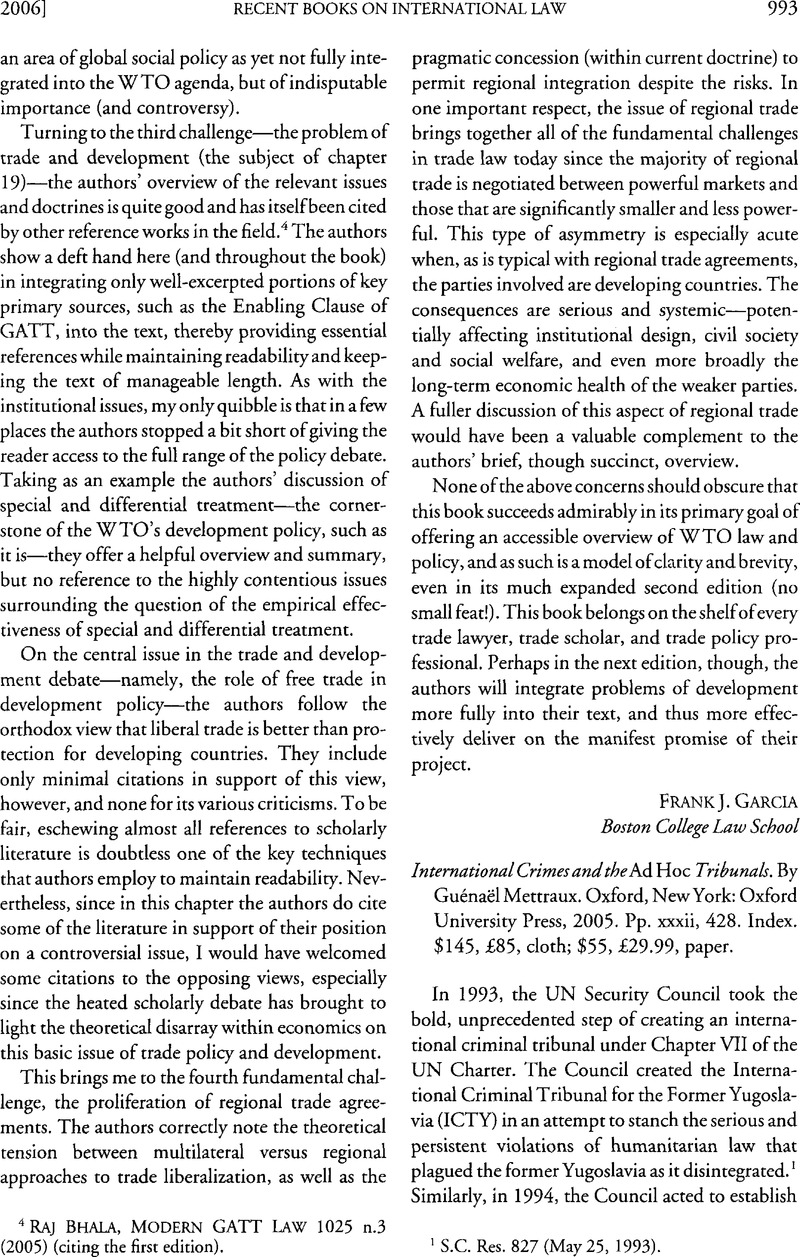No CrossRef data available.
Published online by Cambridge University Press: 27 February 2017

1 One general suggestion along these lines is that, if the authors contemplate a third edition, they consider adding a trade scholar from the developing world with direct experience of the problem of trade and development, although the authors are by no means insensitive to the situation of developing countries in the WTO (indeed, Mavroidis’s work as a WTO legal adviser involves assisting developing countries in their disputes).
2 The authors are similarly effective in their presentation of core WTO disciplines in chapters on tariff rules, national treatment, most-favored-nation, safeguards, dumping, and subsidies. Their discussion offers a very clear and succinct summary of key doctrines and cases.
3 See, e.g., John, H. Jackson, The World Trading System: Law and Policy of International Economic Relations 109 (2ded. 1997).Google Scholar
4 Raj, Bhala, Modern Gatt Law 1025 n.3 (2005)Google Scholar (citing the first edition).
1 S.C. Res. 827 (May 25, 1993).
2 S.C. Res. 955, annex (Nov. 8, 1994).
3 These figures, updated regularly, were taken from the ICTY’s Web site, <http://www.un.org/icty/. All other ICTY materials cited in this article are also available there.
4 These figures, updated regularly, were taken from the ICTR’s Web site, <http://www.ictr.org. All other ICTR materials cited in this article are also available there.
5 See, e.g., Prosecutor v. Tadić, Decision on the Defence Motion for Interlocutory Appeal on Jurisdiction, No. IT-94-1-AR72 (Oct. 2, 1995); Prosecutor v. Marijačić, Judgement, No. IT-95-14-R77.2 (Mar. 10, 2006).
6 Report of the Secretary-General Pursuant to Paragraph 2 of Security Council Resolution 808, para. 34, UN Doc. S/25704(1993).
7 See Lawrence, D. Johnson, Ten Yean Later: Reflections on the Drafting, 2 J. Int’l Crim. Just. 368, 370Google Scholar (quoted by Mettraux at p. 5 n.2).
8 See Report of the Secretary-General Pursuant to Paragraph 5 of Security Council Resolution 955, para. 12 (1994), UN Doc. S/1995/134 (1995) (“In that latter respect, the Security Council has elected to take a more expansive approach to the choice of the applicable law than the one underlying the statute of the Yugoslav Tribunal, and included within the subject-matter jurisdiction of the Rwanda Tribunal international instruments regardless of whether they were considered part of customary international law or whether they have customarily entailed the individual criminal responsibility of the perpetrator of the crime. Article 4 of the statute, accordingly, includes violations of Additional Protocol II, which, as a whole, has not yet been universally recognized as part of customary international law, and for the first time criminalizes common article 3 of the four Geneva Conventions.”).
9 Prosecutor v. Milutinović, Decision on Ojdanić’s Motion Challenging Jurisdiction—Joint Criminal Enterprise, No. IT-99-37-AR72, para. 9 (May 21, 2003).
10 For example, in the case of the Statutes’ prohibition of crimes against humanity, Mettraux defines the general elements as (1) an “attack”; (2) a nexus between the attack and the accused’s acts; (3) the attack is “directed against a civilian population”; (4) the attack is “widespread or systematic”; and (5) the perpetrator has the required mens rea (p. 153).
11 See Prosecutor v. Kupreskić, Judgment, No. IT-95-16-T, para. 631 (Jan. 14, 2000).
12 The two cases Mettraux cites are Prosecutor v. Kmojelac, Motion to Withdraw Article Two Counts, No. IT-97-25-PT (Oct. 27, 2000), and Prosecutor v. Hadzihasanović, Amended Indictment, No. IT-01-47-PT(Jan. 11,2002).
13 He identifies these components as (1) intent, (2) to destroy, (3) in whole or in part, (4) a protected national, ethnical, racial, or religious group (5) as such.
14 See, e.g., Prosecutor v. Sikirica, Judgment on Defence Motions to Acquit, No. IT-95-8-T (Sept. 3, 2001).
15 ICTY Statute, Art. 7.1; ICTR Statute, Art. 6.1. Note that the appeals chamber has determined that “committing” encompasses “joint criminal enterprise” (also known as “common purpose doctrine”) as a form of liability. See Prosecutor v. Tadić, Judgment, No. IT-94-1-A (July 15, 1999); Prosecutor v. Milutinović, Decision on Ojdanić’s Motion Challenging Jurisdiction—Joint Criminal Enterprise, para. 9.
16 Prosecutor v. Hadzihasanovic, Decision on Interlocutory Appeal Challenging Jurisdiction in Relation to Command Responsibility, No. IT-01-47-AR72 (July 16, 2003).
17 Id., Sep. & Part. Diss. Op. Hunt, J., para. 22.
18 ICTY Statute, Art. 24; ICTR Statute, Art. 22.